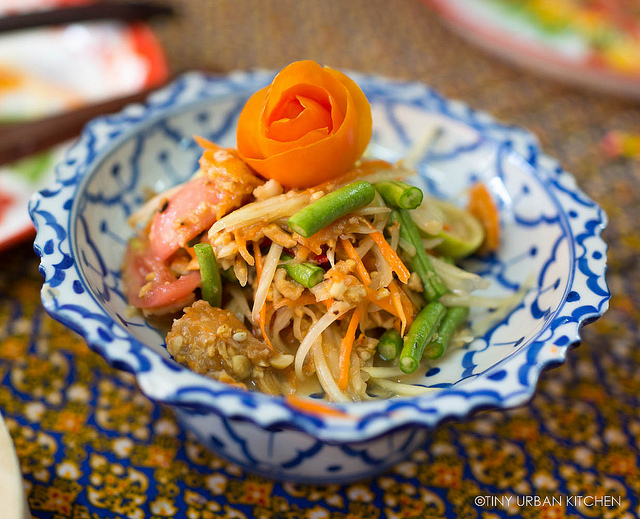
This is the ninth post in the Thailand! travel series of my eats in Bangkok. Other posts include Thip Samai, Best Pad Thai in Bangkok? and Raan Jay Fai, Best Drunken Noodle in Bangkok, Maeklong Railway Market, Floating Markets (Damnoen Saduak), Street Foods of Bangkok, Part I, and Street Foods of Bangkok, Part II, Fun Fruits in Thailand, and Somphong Thai Cooking School.
Som tam.
It's the perfect blend of savory umami, sweet, spicy, and tart. It's cool, refreshing, and a delightful blend of textural contrasts: the crunchy peanuts, crispy vegetables, and juicy tomatoes. Heck, it's even been named as one of world's 50 most delicious foods by CNN.
Som tam literally means "sour pounded" in Thai, and is a refreshingly delicious green papaya salad that's popular all throughout Thailand. It originates from the northeastern part of Thailand, (called Isaan) and due to its proximity to Laos, derives quite a bit of influence from Laos cuisine.
I partly chose this particular cooking class because it included this salad, which I've always wanted to learn how to make. I was thrilled to learn that it's super easy. Getting the ingredients may be the hardest (though still very doable!) part.
The main ingredient in this salad is the green papaya. You want your papaya to be as unripen as possible. It should be really hard and firm. This recipe won't work with papaya that has started to ripen, turn orange, or become soft and sweet.
At the market, Koy showed us an example of a perfect papaya.
I'm pretty sure they sell these in the US, because my mom used to make a version of green papaya salad when I was a kid.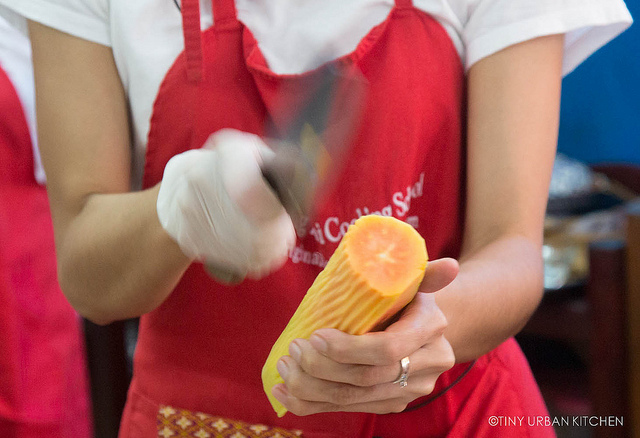
First, you need thin, julienne strips of papaya. Please note, the above papaya is actually borderline too ripe for this recipe (you can see how it's turning orange), but Koy, our instructor, was still able to use it to show us how to create the julienne strips for the salad.
Method 1: Simple Knife
If you have no special tools, you can create the strips with just a sharp knife. This is how a lot of street vendors do it in Thailand.
First, whack away at the papaya to create a bunch of vertical "cuts" into the side (see photo above).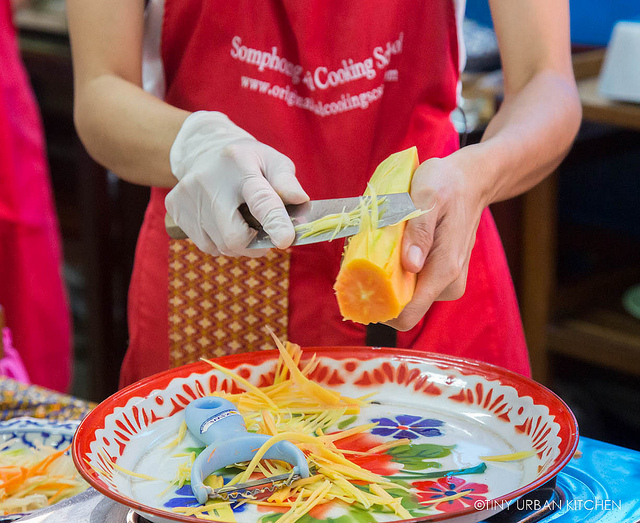
Second, slice these strips onto a plate. It looks easier than it is. I tried to do it, and it was tricky slicing off thin, evenly sized strips.
Method 2: Use a Tool!
Of course, if you feel uncomfortable chopping and cutting, the much easier way is to use a papaya slicer. They recommended the brand Kiwi, which I was surprised to find out is actually available on Amazon! With this slicer, it's easy: you just peel away!
I guess you can probably use a mandolin slicer or any other tools designed for shredding carrots and other related vegetables.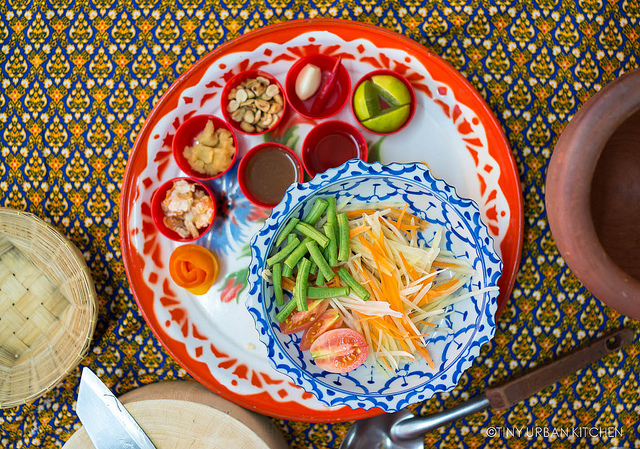
Though you can make this with just papaya, we did it with a mixture of papaya and carrots. It adds a nice color and the two work well together.
Gather all your ingredients. You can get long beans at any Chinese supermarket (we eat them all the time too!). Most of the less common ingredients, such as dried shrimp, palm sugar, and tamarind can probably be found at an Asian grocery (I'm pretty sure I've seen them in Boston).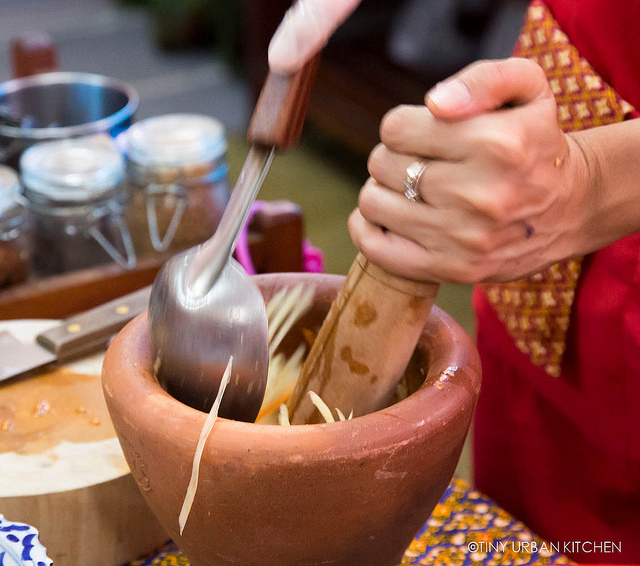
Now, we will pound it all together in a mortar and pestle.
Notice how the som tam mortar and pestle is a little bit taller and narrower? I'm not sure how well this recipe would work with the lower, flatter marble type we typically see in the US, though I'm definitely planning to try it! Alternatively, it's not too expensive to buy a proper one such as this wooden one, though the nice earthenware ones are definitely more expensive.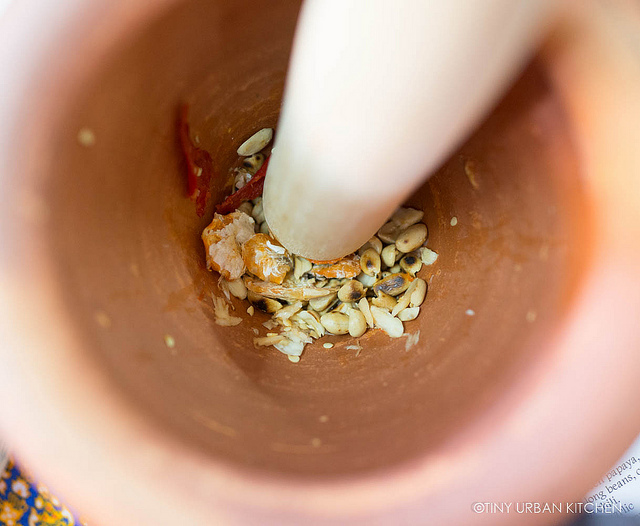
We begin with the dry ingredients. Pound your garlic, dried shrimp, fresh Thai chili, and peanuts with your mortar and pestle until they are crushed.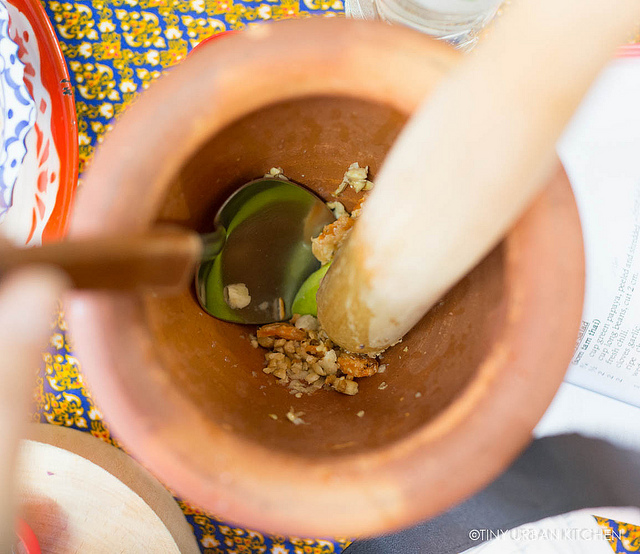
Add the wet ingredients: tamarind juice, fish juice, sugar, and the lime. Keep the skin on one lime edge; squeeze out just the juice for the other lime wedge. At this point, to avoid squirting tart acids into your eyes, do a "pound and stir" motion with a spoon. Mix the ingredients together.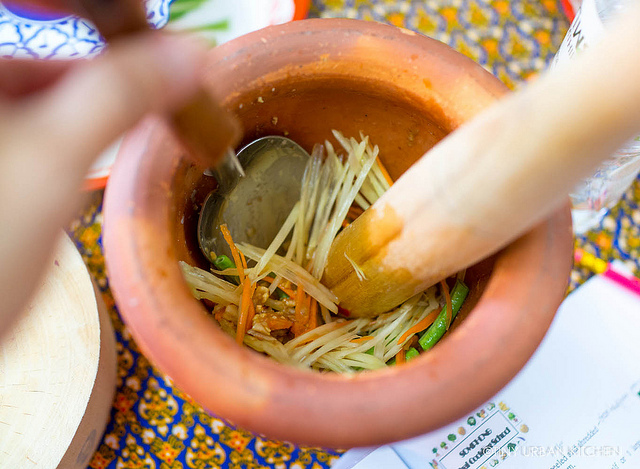
Once the sauce is nicely mixed, add the papaya strips, carrot strips (if you have any), long beans, and tomatoes.
Continue the pounding + stirring motion with the spoon and pestle until everything is well mixed.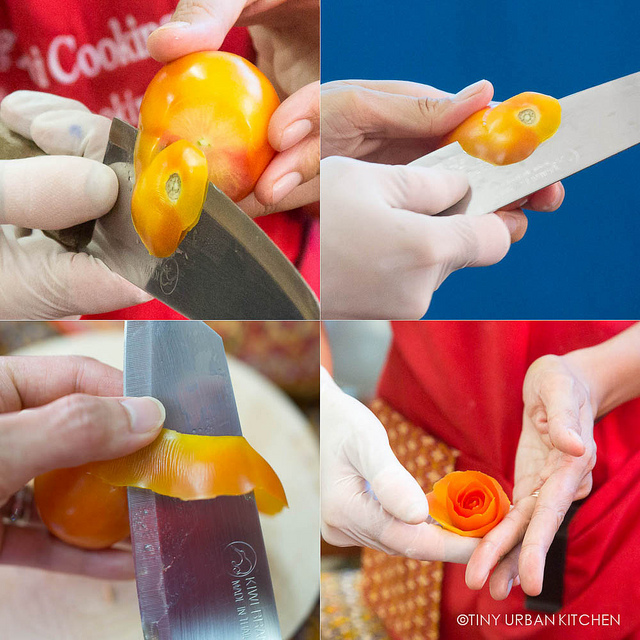
Just for fun, we also learned how to make "tomato roses." It's actually not as hard as it looks, and the end result is gorgeous! Using a sharp knife and starting at the top of the tomato, slowly cut off the skin of a tomato (we used these pretty orange ones), trying to keep the width consistent (about 2-3 cm or ½ inch). Keep the bottom of the tomato to serve as a base.
Gradually roll the skin in a spiral, trying to keep it as tight as possible.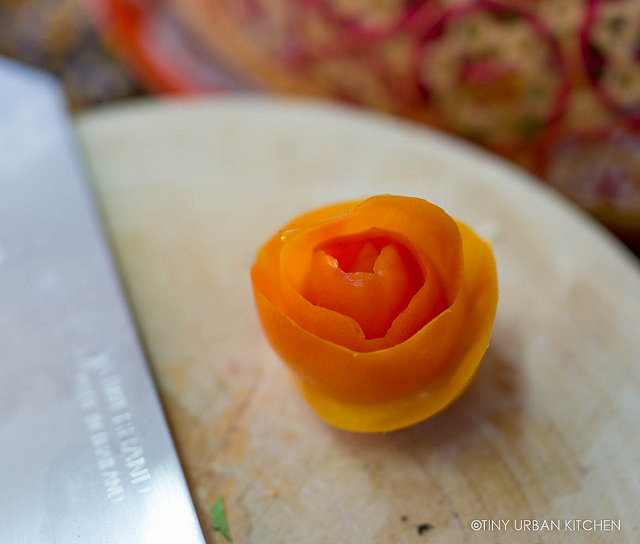
How pretty is that?
Dump your som tam into a bowl (juices and all). Ideally, it's a pretty Thai bowl for your pictures.
For garnish, top with the remaining crushed peanuts and optionally top with your rose.
So pretty, so delicious, and healthy!
I could eat this everyday.
Enjoy!
Som Tam Thai [Papaya Salad]
¾ cup shredded green papaya
½ cup long beans, cut into 1 inch pieces
2 Thai chilies
2 cloves of garlic
2 cherry tomatoes, sliced in half
1 teaspoon ground dried shrimp
2 T crushed peanuts
½ lime, sliced into quarters
1 T palm sugar
1 ½ T fish sauce
2 T tamarind juice
Pound garlic, chili, dried shrimp, and 1 T of the peanuts in a mortar and pestle. Add tamarind juice, fish sauce, sugar, and lime (1 wedge with skin, 1 wedge add juice only). Continue to pound and stir. Add long beans, papaya, and tomatoes. Mix well, and top with remaining peanuts and optionally a tomato rose.
*Note*
Palm sugar can be found at most Asian supermarkets (I've definitely seen it in Boston). If necessary, regular sugar can probably be substituted, but add less, since it's a bit sweeter and more refined.
All Rights Reserved









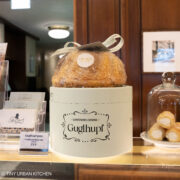

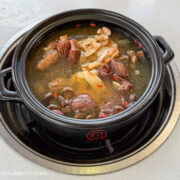

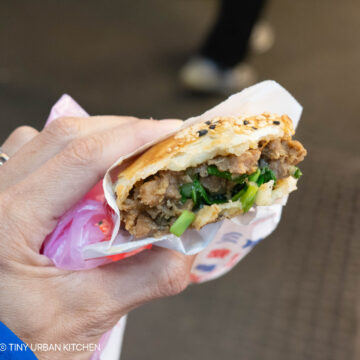
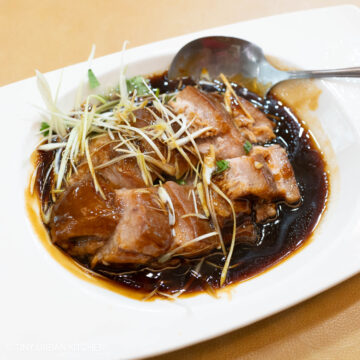
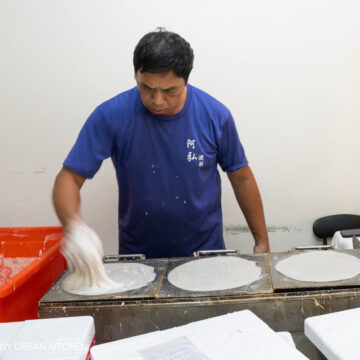

[…] Stoneware or Terracotta are also used. My favourite Thai dish, som tam, is made in a terracotta mortar with a wooden pestle. The Japanese version, suribachi and surikogi, also use a mix of materials. These are a bit harder to find—on my next trip to Thailand, I’ll be bringing back one of these so I can make som tam! […]